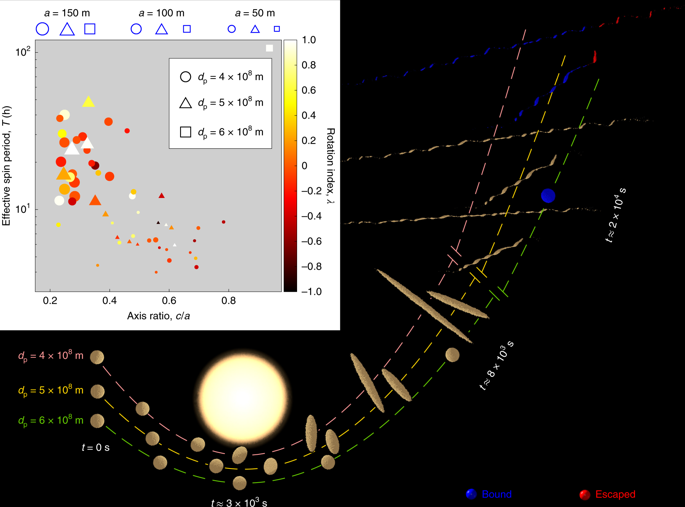Nature Astronomy ( IF 12.9 ) Pub Date : 2020-04-13 , DOI: 10.1038/s41550-020-1065-8 Yun Zhang , Douglas N. C. Lin

|
The first discovered interstellar object (ISO), ‘Oumuamua (1I/2017 U1) shows a dry and rocky surface, an unusually elongated shape, with short-to-long axis ratio c∕a ≲ 1∕6, a low velocity relative to the local standard of rest (~10 km s−1), non-gravitational accelerations and tumbles on a timescale of a few hours1,2,3,4,5,6,7,8,9. The inferred number density (~3.5 × 1013−2 × 1015 pc−3) for a population of asteroidal ISOs10,11 outnumbers cometary ISOs12 by ≥103, in contrast to the much lower ratio (≲10−2) of rocky/icy Kuiper belt objects13. Although some scenarios can cause the ejection of asteroidal ISOs14,15, a unified formation theory has yet to comprehensively link all ‘Oumuamua’s puzzling characteristics and to account for the population. Here we show by numerical simulations that ‘Oumuamua-like ISOs can be prolifically produced through extensive tidal fragmentation and ejected during close encounters of their volatile-rich parent bodies with their host stars. Material strength enhanced by the intensive heating during periastron passages enables the emergence of extremely elongated triaxial ISOs with shape c∕a ≲ 1∕10, sizes a ≈ 100 m and rocky surfaces. Although volatiles with low sublimation temperature (such as CO) are concurrently depleted, H2O buried under surfaces is preserved in these ISOs, providing an outgassing source without measurable cometary activities for ‘Oumuamua’s non-gravitational accelerations during its passage through the inner Solar System. We infer that the progenitors of ‘Oumuamua-like ISOs may be kilometre-sized long-period comets from Oort clouds, kilometre-sized residual planetesimals from debris disks or planet-sized bodies at a few astronomical units, orbiting around low-mass main-sequence stars or white dwarfs. These provide abundant reservoirs to account for ‘Oumuamua’s occurrence rate.
中文翻译:

潮汐破碎化是1I / 2017 U1('Oumuamua)的起源
首次发现星际对象(ISO),“Oumuamua(1I / 2017 U1)示出了干燥和岩石表面,一个不同寻常的细长形状,具有短到长轴比率c ^ /一个 ≲ 1/6,相对于以较低速度静止的当地标准(〜10 km s -1),非重力加速度和以小时为单位的时间滚动1,2,3,4,5,6,7,8,9。所推断出的数密度(〜3.5×10 13 -2×10 15 PC -3为的小行星ISO文件群)10,11租税彗星的ISO 12由≥10 3,在对比的是低得多的比率(≲ 10 -2)岩石/冰冷的柯伊伯带天体13。尽管某些情况可能会导致小行星ISO 14,15的弹出,但统一的编队理论尚未全面联系所有'Oumuamua'令人费解的特征,并考虑到人口。在这里,我们通过数值模拟表明,'Oumuamua样的ISO可以通过大量的潮汐破碎而大量产生,并在其挥发性丰富的母体与宿主恒星紧密相遇时弹出。期间近星点通路由密集加热增强材料强度使得能够极其细长三轴ISO文件的出现与形状Ç /一个 ≲ 1/10,尺寸一 ≈100 m,岩石表面。尽管同时消耗了低升华温度的挥发物(例如CO),但掩埋在表面下的H 2 O被保留在这些ISO中,从而为“ Oumuamua”在通过内部太阳系期间的非重力加速度提供了无可计量的彗星活动的除气源。 。我们推断,类似'Oumuamua'的ISO的祖先可能是来自奥尔特云的千米大小的长周期彗星,来自碎片盘的千米大小的剩余小行星或位于几个天文单位的行星大小的天体,围绕着低质量主星运行。序星或白矮星。这些提供了丰富的水库来解释'Oumuamua'的发生率。









































 京公网安备 11010802027423号
京公网安备 11010802027423号